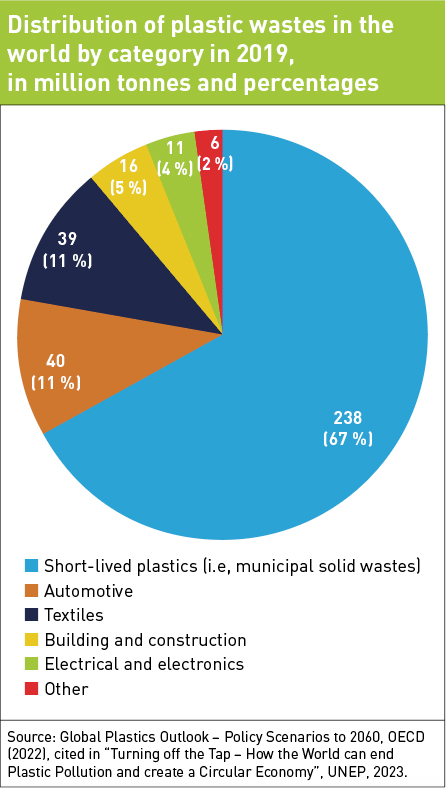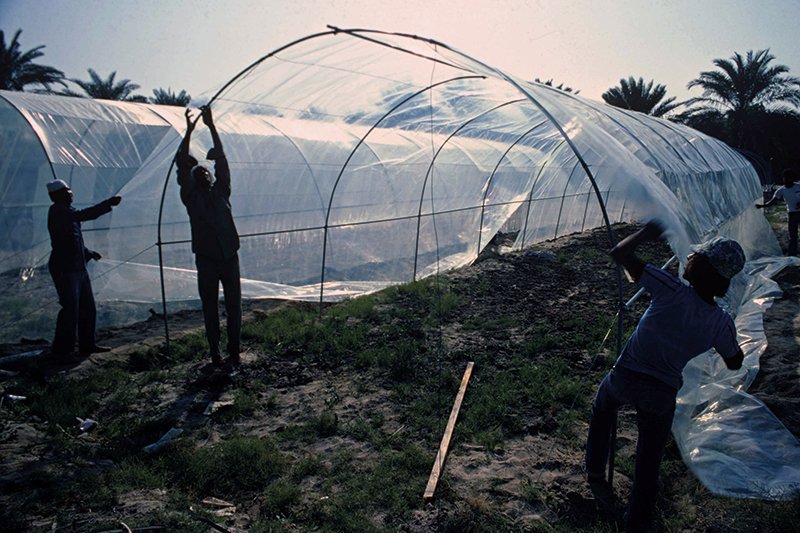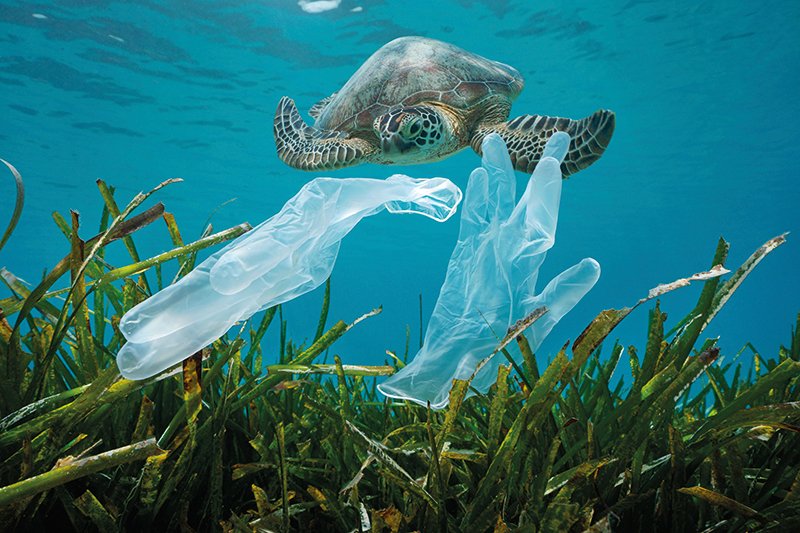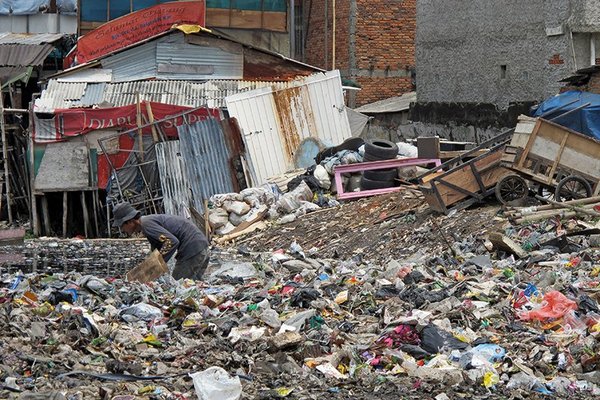 Download this article in magazine layout
Download this article in magazine layout
- Share this article
- Subscribe to our newsletter
Towards a sustainable plastic future
Plastic pollution has emerged as a major threat to human and natural ecosystems. According to a United Nations report, the world is producing around 430 million tonnes (Mt) of plastics per year of which two-thirds are for short-term use. Because of its versatility, low production costs and use value, the production and consumption of plastic products has grown exponentially since the 1950s. Global production of plastics, which was about 1.5 Mt in 1950, rose to over 400 Mt by 2022.
A 2022 report by the Organisation for Economic Co-operation and Development (OECD), “Global Plastics Outlook: Policy Scenarios to 2060”, states that if present trends persist, global plastics production will triple and exceed one billion tonnes by 2060.
The plastic industry
With a 32 per cent share, China was the largest producer of plastic materials in the world in 2022. The percentages for the rest of Asia were 19 per cent, 17 per cent for North America, 14 per cent for Europe and 18 per cent for other regions. Around 9 million people are employed in polymer production and plastic processing industries. If we add those employed in the informal sector, e.g. waste collectors and recyclers who collect plastic products such as plastic milk sachets, plastic bottles, bags and containers, this number will be much higher. The United Nations Conference on Trade and Development (UNCTAD) estimates the global trade in plastics to be about one trillion US dollars (USD) every year, or around 5 per cent of the total merchandise trade. Primary forms of plastics make up the largest share of the trade in volume (56 %), followed by intermediate forms (11 %), intermediate manufactured goods (5 %), final manufactured products (21 %) and waste (2 %). The USA, the European Union, Saudi Arabia and South Korea are the largest exporters of primary forms of plastics in the world. The plastic industry is one of the largest manufacturing industries in the USA, generating 451 billion USD per year in shipments and employing about one million people directly and another 1.5 million indirectly. While the primary plastics sector of polymers and additives accounts for around 600-700 billion USD per year in revenues, it also inflicts a heavy burden on human health and environmental degradation, with the poorest in society facing the highest impacts although contributing the least to plastic over-consumption and waste (UNEP 2021).
A multi-faceted problem
The per capita annual consumption of plastics in the world is highest in Hong Kong (167 kg) and Iceland (128.9 kg). The USA, Saudi Arabia, the Netherlands, Canada and Norway reported comparatively high annual per capita plastic consumption of between 53 and 69 kg. Ten countries account for around 50 per cent of the total plastic wastes produced in the world, with China ranking as the largest producer of plastic wastes, with an annual production of 60 Mt, followed by the USA (42 Mt), Brazil (11.3 Mt), India (9.46 Mt), Japan (9 Mt), Russia (8.47 Mt), Indonesia (7.8 Mt), Germany (6.5 Mt), the UK (6.4 Mt) and Mexico (5.9 Mt). The Plastic Overshoot Day Report 2023 by Environmental Action, a Switzerland-based non-governmental organisation, notes that twelve countries in the world, among them India, China, Brazil, Indonesia, the USA and Saudi Arabia, together account for around 52 per cent of the world’s mismanaged plastic wastes.
About 67 per cent of the plastic wastes generated in the world (353 Mt) in 2019 were short-lived plastics consisting mainly of municipal solid wastes, whereas the remaining plastic wastes were generated from other activities and industries (see Figure below). Over 350 Mt of plastic wastes are generated every year, a volume projected to rise to over one billion Mt by 2060. Of the total plastic wastes produced, less than 10 per cent is recycled, and about 15 per cent is incinerated, while the remainder is dumped in landfills or littered on land, rivers, lakes and the oceans. This has adverse economic, social, environmental and health impacts. Plastics can take up to 500 years or more to decompose and emit pollutants which degrade the environment and are harmful for humans, animals including livestock, aquatic and marine life. Plastic wastes dumped in soils affect soil quality and biodiversity as well as groundwater aquifers. Microplastics in soils pose a threat to soil biodiversity, food safety, and human and animal health. Cases of wild animals, birds and cattle dying after ingesting microplastics are not uncommon. A news item in the “Times of India” in 2017 stated that about a thousand cattle die every year in Lucknow city, India, due to ingesting plastic wastes. Another news report in the “Deccan Herald” (March 4th, 2021) revealed that veterinarians who operated on an ailing pregnant cow in Bangalore, India, found 71 kg of plastics, nails and other wastes in its stomach. Both the cow and its unborn calf died later. Plastic waste has been found in the deepest recesses of the oceans, on pristine mountain tops, on land, and in rivers and lakes. It has adversely impacted biodiversity on land and in the seas.

Health impacts
Traces of microplastics have been found in breast milk, tap water and the blood stream of humans. A study on “The Plastic in our Drinking Water” conducted by Orb Media in 2017 found that 83 per cent of tap water samples from around the world contained plastic pollutants. The study found the contamination rate of tap water with microplastics to be the highest (94 %) in the USA, followed by Lebanon (93 %) and India (82 %). The UK, Germany and France reported the lowest contamination rate, although it was still as high as 72 per cent. According to the study, people may be ingesting 3,000-4,000 micro particles of plastics through their tap water every year. A study by Heather Leslie et al. in 2022 detected the presence of microplastics in 80 per cent of the blood test samples of the surveyed population. However, this study was based on a limited sample of 22 healthy volunteers. Some of the chemicals present in plastics are carcinogenic for both humans and animals.
Renowned environmentalist Sir David Attenborough suggested that between 400,000 and one million people die every year through plastic pollution, especially in developing countries, due to poor management of plastic and other wastes.
Agricultural plastic pollution
Plastics find widespread use and application in the agricultural sector for crop and livestock production, aquaculture, fisheries and forestry. These include greenhouse, mulch and silage films, pesticide containers, tree guards, fertiliser coatings, irrigation tubes and pipes, nets, ropes and fishing gear. A 2021 report by the Food and Agriculture Organisation (FAO) entitled “Assessment of Agricultural Plastics and their Sustainability – A Call for Action” notes that in 2019, agricultural value chains used 12.5 Mt of plastic products in plant and animal production and 37.3 Mt in food packaging. Data were not available for usage in storage, processing and distribution. The report forecasts the global demand for greenhouse, mulching and silage films to increase by 50 per cent from 6.1 Mt in 2018 to 9.5 Mt in 2030. The crop production and livestock sectors are the largest users of plastic products, accounting for 10 Mt per year collectively, followed by fisheries and aquaculture with 2.1 Mt, and forestry with 0.2 Mt. Among regions, Asia was estimated to be the largest user of plastics in agricultural production, responsible for up to 6 Mt annually, which is almost half of the global usage. The Table on page 40 gives examples of plastics used in agriculture and fisheries and their substitutes, along with their advantages and disadvantages.

Plastics are widespread in agriculture, e.g. as films in tunnels and greenhouses.
Photo: Franco Mattioli/ FAO
Marine plastic pollution
It is estimated that 11 Mt of plastics enter the oceans every year, a volume projected to triple in the next two decades. Plastic wastes apart from other debris such as abandoned fishing nets and gear caused by poorly regulated commercial fisheries have been found in all oceans and at all depths. Over the period 1970 to 2019, an estimated 30 Mt of plastic wastes have accumulated in the oceans, while over 100 Mt have ended up in rivers and lakes. Asia accounts for over 50 per cent of the oceanic plastic pollution. Plastics form 85 per cent of marine litter and have aggravated marine pollution and affected marine species and biodiversity. Corals that encounter plastic wastes in the oceans are highly prone to contract diseases and infections.
Experts suggest that around 100,000 marine mammals such as whales, dolphins, seals and turtles die every year because of marine plastic pollution. Every year, about one million sea birds die having ingested microplastics or having got entangled in plastics debris. Some studies even suggest that by the year 2050 we may find more plastics in the seas than fish.

Photo: Damsea/shutterstock.com
Ending plastic pollution with a circular economy
According to a 2023 report by the United Nations Environment Programme (UNEP) entitled “Turning off the tap – How the world can end plastic pollution and create a circular economy”, the annual social and environmental costs of plastic pollution are estimated to range between 300 and 600 billion USD per year, with some suggesting them to be still higher, at around 1.5 trillion USD per year.
Plastic pollution will also contribute to global warming. The UNEP report states that under a business-as-usual scenario, plastics will contribute about 19 per cent of the greenhouse gas (GHG) emissions by 2040.
To tackle the plastic crisis the UNEP report has proposed a systematic approach to combat plastic pollution by relying on the 3R strategy i.e. Reuse, Recycle, and Reorient, and diversifying as well as tackling the legacy of plastic pollution.
Reuse: This involves accelerating the market for reusable products, to transform the throwaway economy to a reuse society by creating an enabling environment to ensure that the reuse market has a stronger business case than the single-use plastics market.
Recycle: This centres on accelerating the market for plastic recycling by ensuring that recycling becomes a more stable and profitable venture and reducing the amount of plastic pollution by an additional 20 per cent by 2040. As per UNCTAD, the value of the global plastic recycling industry is projected to grow from 34 billion USD in 2019 to 60 billion USD in 2027.
Reorient and Diversify: Here, a market is created for plastic alternatives to enable sustainable substitutions, thus avoiding replacing plastic products with alternatives that displace rather than reduce impacts. It is estimated that sustainable alternatives could reduce plastic pollution by 17 per cent by 2040.
The report states that these measures could lead to an 80 per cent reduction in plastic pollution and a net increase of 700,000 jobs by the year 2040. They are also expected to create new job opportunities in the informal sector as well as to encourage innovation. Further, apart from reducing annual GHG emissions by 0.5 gigatonnes of carbon dioxide equivalent, they could lead to saving 1.3 trillion USD in direct public and private costs between 2021 and 2040 and avoiding 3.3 trillion USD of environment and social costs due to plastic pollution. They will also reduce liabilities, risks and litigation associated with damages from plastic pollution. For instance, a study by Andreas Merkl and Dom Charles on “The Price of Plastic Pollution – Social Costs and Corporate Liabilities” suggests that corporate liabilities of companies causing plastic-related pollution in the United States are likely to exceed 20 billion USD between 2022 and 2030.
The OECD report tries to build plausible plastic futures using two alternative policy scenarios – a regional action scenario comprising a mix of fiscal and regulatory policies primarily in OECD countries and a global action scenario involving more stringent policies implemented world-wide. Under the regional action scenario, it found that this would likely decrease plastic wastes by almost a fifth and reduce plastic leakage into the environment by more than half, with global GDP declining by only 0.3 per cent by 2060. Under the global action scenario, it found that this is likely to reduce plastic wastes by a third and almost eliminate plastic leakage to the environment while lowering global GDP by an estimated 0.8 per cent. However, this overlooks the tangible and intangible benefits of the avoided damages caused by plastic pollution.
To tackle the adverse environmental impacts of plastic use and encourage a transition to a sustainable plastics future a host of measures are needed. These include:
- raising taxes on plastics and plastic packaging as well as imposing a tax on virgin plastic production,
- giving incentives to reuse and repair plastic items,
- mandating targets for recycled content in new plastic products,
- providing and enforcing extended producer responsibility (EPR) schemes for promoting sustainable use and management of plastics,
- adopting practices in agriculture and other sectors that avoid the use of plastics,
- eliminating the most polluting plastic products,
- substituting plastic products with natural or biodegradable alternatives,
- adopting new business models that save or avoid plastic use,
- improving waste management infrastructure and hiking litter collection rates,
- establishing fiscal measures and incentives that drive behavioural change within the supply chain, and among users and consumers,
- reducing financial flows for virgin plastic production by 2.2 billion USD by the year 2040,
- increasing financial flows for sustainable plastic alternatives by 1.7 trillion USD by the year 2040 for production of sustainable plastic alternatives and technologies,
- increasing financial flows for waste collection and sorting systems in developing countries and improving recycling technologies and enhancing recycling capacity.
Being an internationally traded commodity, only coordinated global action can effectively tackle the plastic problem. Although most countries in the world have banned the manufacture and use of single-use plastics this addresses only a fringe of the problem. The fifth United Nations Environment Assembly, which met in Nairobi/Kenya in March 2022, resolved to enact a legally binding global plastics treaty by the year 2024 to tackle the plastic crisis which was endorsed by all the 193 member countries. However, the fourth session of the Intergovernmental Negotiating Committee entrusted with the task of framing the treaty, which met in Ottawa, Canada during April 23rd-29th, 2024, was unable to reach a consensus because of opposition from oil and plastic producing countries who refused any curbs on their production. One hopes that countries will keep the larger interests of society and the planet in view and agree to a global plastic treaty by the end of this year.
K. N. Ninan is Lead Author of the GEO-7, United Nations Environment Programme, Nairobi, Kenya and Chairperson of the Centre for Economics, Environment and Society, Bangalore, India. Prior to this he was Senior Fellow at the World Resources Institute India, New Delhi, Lead Author of Working Group III, Sixth Assessment Report of the Intergovernmental Panel on Climate Change, Geneva, Switzerland, and Co-Chair of the Methodological Assessment of Scenarios and Models of Biodiversity and Ecosystem Services at the Intergovernmental Science-Policy Platform on Biodiversity and Ecosystem Services, Bonn, Germany. He was also Professor of Ecological Economics at the Institute for Social and Economic Change, Bangalore, India.
Contact: ninankn@yahoo.co.in




Add a comment
Be the First to Comment